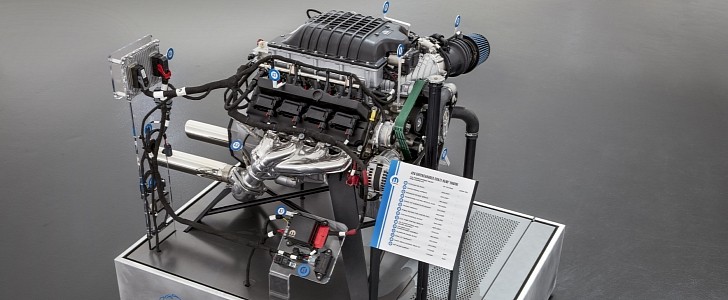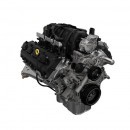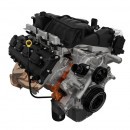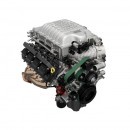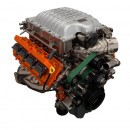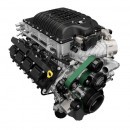The hemispherical combustion chamber from which Chrysler took inspiration for the HEMI dates back to at least 1901. Invented by Allie Ray Welch and patented in November 1907, the hemispherical combustion chamber helps the HEMI stands out from other pushrod-actuated V8s.
As the name implies, the shape of the combustion chamber is half of a sphere. Road-going vehicles use this design since at least 1905 thanks to Belgian automaker Pipe, and Fiat tested this design on the track in 1907. During World War II, hemispherical combustion chambers were used in military applications such as the Continental AV-1790-5B air-cooled V12 of the M47 Patton, which produces a very respectable 810 horsepower.
Chrysler’s foray into hemispherical combustion chambers began in Anno Domini 1950 for MY 1951 with the FirePower, which took influence from the automaker’s military experience from World War II. Lest we forget, Chrysler developed an experimental Hemi engine for the P-47 Thunderbolt, a 36.4-liter V16 that cranks out a simply ridiculous 2,500 horsepower.
Also called FireDome and Red Ram, the first-generation Hemi was discontinued in 1959 for the wedge-head B engine. The second-generation Hemi came out in 1964 with the displacement we all know and love: 426 cubic inches or 7.0 liters. Developed specifically for use in NASCAR, the so-called Elephant engine was adapted for street use in 1965 for the 1966 model year in vehicles such as the Dodge Coronet and Dodge Charger.
Chrysler used the Hemi moniker for an Australian-built I6 and a Mitsubishi-built I4 in the 1970s and 1980s, only to revive this nameplate once again in the 2000s with the third-generation HEMI, the one with uppercase letters. When it comes to crate engines, the third-gen HEMI is available in five flavors right now, starting with the 345, also known as the Eagle engine.
Excluding the front-end accessory drive kit and controller kit, the 5.7-liter HEMI is available through Mopar for $7,495 at press time. Good for 383 horsepower and 417 pound-foot (565 Nm), this lump comes with a water pump, flywheel and clutch, front sump oil pan, intake manifold complete with a throttle body, fuel injectors, and coil packs. Designed to take premium-grade dinosaur juice, the 345 is rocking a 24-month warranty.
Codenamed Apache, the 392 features a cast-iron block with four-bolt powder metal caps, just like the 345. The naturally-aspirated behemoth boasts forged steel for the crankshaft, floating pin connecting rods, hypereutectic aluminum-alloy pistons that enable tighter clearances, a nodular iron camshaft, 319 aluminum cylinder heads, and a 10.9:1 compression ratio.
Priced at $9,600, the 485-horsepower 392 also comes with a premium fuel recommendation. Just like the 345, this fellow is designed for installation in any pre-1976 model year vehicle. If equipped with this engine and driven on public roads, vehicles produced for model year 1976 and later may violate U.S., Californian, Canadian, or local vehicle emission regulations.
Rolled out for the 2015 model year in the Challenger and Charger, the Hellcat’s crate engine sibling is dubbed Hellcrate. Prospective customers are offered two flavors of this engine: Hellcrate or the Hellcrate Redeye.
The most important difference between these supercharged mills comes in the guise of the supercharger’s displacement: 2.4 or 2.7 liters, both supplied by Japanese engineering corporation IHI. Presently listed by Mopar at $17,925 excluding accessories, the standard specification is a bonafide monster that develops 717 horsepower and 656 pound-foot (889 Nm) of torque.
In Redeye format, make that 807 horsepower and 717 pound-foot (972 Nm) for the princely price of $21,807. Another difference between these 376-ci lumps comes in the form of maximum engine speeds: 6,200 versus 6,500 revolutions per minute. Both feature 356 aluminum cylinder heads, cast-iron blocks, forged-steel crankshafts, and a compression ratio of 9.5:1.
Hellephant is the ultimate incarnation of the third-generation HEMI, a crate engine that’s loosely related to the Hellcrate. Yours for a cool $29,995 although it’s temporarily unavailable, this 426-ci leviathan is rated at 1,000 horsepower and 950 pound-foot (1,288 Nm) of twist. Unveiled at the 2018 SEMA Show, the Hellephant originally sold out in just under 48 hours.
Once again, IHI supplies the 3.0-liter supercharger that plays a vital role in the force-fed V8 delivering 1,000 ponies. Capable of 6,800 revolutions per minute, the Hellephant uses a cast-aluminum block, forged H-beam connecting rods, ARP 2000 bolts, forged aluminum pistons, nodular iron for the camshaft, 356 aluminum heads, and a compression ratio of 9.5:1.
Chrysler’s foray into hemispherical combustion chambers began in Anno Domini 1950 for MY 1951 with the FirePower, which took influence from the automaker’s military experience from World War II. Lest we forget, Chrysler developed an experimental Hemi engine for the P-47 Thunderbolt, a 36.4-liter V16 that cranks out a simply ridiculous 2,500 horsepower.
Also called FireDome and Red Ram, the first-generation Hemi was discontinued in 1959 for the wedge-head B engine. The second-generation Hemi came out in 1964 with the displacement we all know and love: 426 cubic inches or 7.0 liters. Developed specifically for use in NASCAR, the so-called Elephant engine was adapted for street use in 1965 for the 1966 model year in vehicles such as the Dodge Coronet and Dodge Charger.
Chrysler used the Hemi moniker for an Australian-built I6 and a Mitsubishi-built I4 in the 1970s and 1980s, only to revive this nameplate once again in the 2000s with the third-generation HEMI, the one with uppercase letters. When it comes to crate engines, the third-gen HEMI is available in five flavors right now, starting with the 345, also known as the Eagle engine.
Codenamed Apache, the 392 features a cast-iron block with four-bolt powder metal caps, just like the 345. The naturally-aspirated behemoth boasts forged steel for the crankshaft, floating pin connecting rods, hypereutectic aluminum-alloy pistons that enable tighter clearances, a nodular iron camshaft, 319 aluminum cylinder heads, and a 10.9:1 compression ratio.
Priced at $9,600, the 485-horsepower 392 also comes with a premium fuel recommendation. Just like the 345, this fellow is designed for installation in any pre-1976 model year vehicle. If equipped with this engine and driven on public roads, vehicles produced for model year 1976 and later may violate U.S., Californian, Canadian, or local vehicle emission regulations.
Rolled out for the 2015 model year in the Challenger and Charger, the Hellcat’s crate engine sibling is dubbed Hellcrate. Prospective customers are offered two flavors of this engine: Hellcrate or the Hellcrate Redeye.
In Redeye format, make that 807 horsepower and 717 pound-foot (972 Nm) for the princely price of $21,807. Another difference between these 376-ci lumps comes in the form of maximum engine speeds: 6,200 versus 6,500 revolutions per minute. Both feature 356 aluminum cylinder heads, cast-iron blocks, forged-steel crankshafts, and a compression ratio of 9.5:1.
Hellephant is the ultimate incarnation of the third-generation HEMI, a crate engine that’s loosely related to the Hellcrate. Yours for a cool $29,995 although it’s temporarily unavailable, this 426-ci leviathan is rated at 1,000 horsepower and 950 pound-foot (1,288 Nm) of twist. Unveiled at the 2018 SEMA Show, the Hellephant originally sold out in just under 48 hours.
Once again, IHI supplies the 3.0-liter supercharger that plays a vital role in the force-fed V8 delivering 1,000 ponies. Capable of 6,800 revolutions per minute, the Hellephant uses a cast-aluminum block, forged H-beam connecting rods, ARP 2000 bolts, forged aluminum pistons, nodular iron for the camshaft, 356 aluminum heads, and a compression ratio of 9.5:1.
